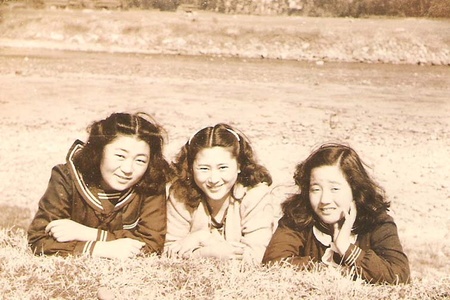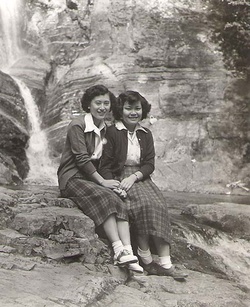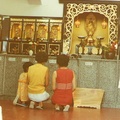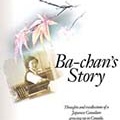When Japan surrendered in August 1945, some Issei parents strongly believed that Japan lost the war through a deadly weapon but was not defeated in a spiritual sense. After the war the Canadian government gave everyone a choice to remain in Canada and be moved inland or to return to Japan. My parents really had to weigh the pros and cons of these choices. The most prominent factors were, no savings left, no jobs and no house to go to. Their cultural roots were in Japan. There also was a language barrier and there were the many restrictions and limitations placed on the children’s choices of entering most professions. All these factors made a future in Canada look rather bleak so a painful decision was made to return to Japan. On the positive note, Papa would be able to see his aging mother and his eldest son who was stranded in Japan when he went to study at the age of 12.
Although Mama firmly believed that it was wiser to remain in Canada because she thought the reckless war had brought great destruction to Japan, the final decision was Papa’s to go to Japan. The Canadian Government essentially encouraged the Japanese to make this decision because the passage was paid and extra food ration coupons for buying basic foods were provided. In hindsight, it leads me to believe that this choice of returning to Japan was the Government’s motive and plan for “ethnic cleansing”. I was underage at 15 and had no choice but to follow my parents. Being born Canadian, I was virtually being exiled but I did not think too much about how I would be treated in Japan. Deep inside, I had mixed feelings. It was sad to be leaving all our friends and my classmates. However, it was exhilarating thinking that I would be enrolling into Jyo Gakko. I had read books and seen films related to this all girls school and I was inspired.
This was the first time I left the country of my birth and my initial impression I felt when we sailed into Yokohama harbour by ship on October 15, 1946 was “Wow, what an unique country, full of curiosities and uncertainties for sure.” It was far from what I had envisioned — this beautiful nation with graceful Mt. Fuji’s white peak reaching upward beyond the clouds. I was confused and somewhat unsettled by the contrast between the east and the west but we had landed and adventure awaited us. My brother, Kakuichiro met us at the harbour. We were surprised to learn that he had written to Papa and Mama through the Red Cross advising us not to return to Japan at this time but his letter never reached my parents so our life was about to begin. We were placed in a holding refugee camp at Kurihama. I thought to myself, “Oh, not again!” Meals were prepared for us but absolutely nothing tasted good, as it was a gooey mixture of something. However, I enjoyed seasonal sweet potatoes. Some less fortunate indigenous Japanese came with buckets to collect the left over food every day.
Our next move was to Uruzu, Fukuoka-ken, a farming community and we relied mainly on support from my brother, and two sisters who worked for the American Armed Forces. Our brother, Tokugi and sister, Wakiko regularly sent us delightful care packages of food and medicine from Canada and the penicillin probably saved my younger sister’s life when she became gravely ill. Food that we brought back from Canada was scarce and we shared them with our relatives and friends and in return we were provided with fresh vegetables and fruits. We were not so lucky when we encountered worms in our stomachs though!
When enrolling into the elementary school, I found out that I was registered as a Japanese citizen already, thus I had dual citizenship. Although I found myself in an all Japanese environment again as in Lemon Creek, I was considered different in my thoughts, the way I dressed, my mannerism, my speech, — everything about me. At school it was customary to remove your outdoor footwear when you enter. Although I did not sense outward discrimination towards me I began to notice “spit” in my leather shoes, which was very disturbing. To become accepted, the only alternative was to wear geta which were wooden sandals like what the others wore. Slowly as I tried to become more like them, my schoolmates started to accept me by the end of the semester.
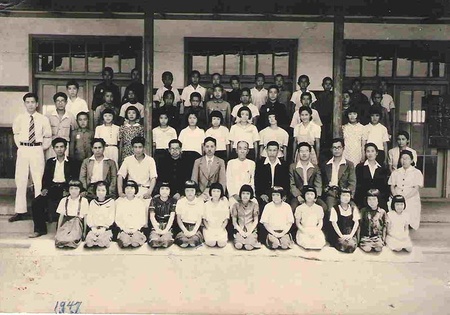
Japan 1947: Public School Yatsuki Chugakko. I was older than the other students (third row, third from right). I looked like the teacher.
When General Douglas MacArthur, commander of occupied Japan, ordered the Americanization of the Japanese educational system, I was truly disappointed that I would not be able to attend the all girls Jyo Gakko. While radical changes were being made to the educational system there were chaotic confusions, concerns and anger reflected in the students’ behaviour and protests against such reforms. War ravaged Japan’s number one priority was to rebuild a stronger, more meaningful and yet affordable education system. If the nation was to grow wealthy and strong, it was believed that it was important to raise the intellectual level of the masses. Eventually the reforms were accepted to a degree and the schools became an interesting blend of the new world and the old world with traditional fine arts still retained.
By the time I reached Sr. High School, I had adjusted quite well to my schooling. The indigenous students and teachers labeled us as “hikiage-sha” meaning uprooted from other countries or repatriates. However, we were all compatible in the classroom setting. I volunteered and assisted in conversational and written English lessons for the indigenous students and they in turn, helped me with the classroom routines, work ethics, and to understand their customs and language. I was pleased to be accepted and respected by my fellow students and teachers. This was an important time for building personal relationships. A deep impact still remains from a small token of kindness of bringing a simple day to day delight. My “sweet potato” friend, Shibashi-san, who lived on a farm knew that I liked certain foods and she would sometimes surprise me with special purple skinned sweet potatoes. They were so delicious that I was very thankful. These potatoes were the best tasting “ama imo” I have ever eaten!
As time went on I took the opportunity when it arose to act as an interpreter to an officer, Lt. Cowan, from the nearby Tsuiki American Airbase. He came to our school and spoke about American life and why the Armed Forces were occupying Japan and their role at the Airbase to combat the North Korean communist enemy. Since then, doors opened to work for the Armed Forces in various capacities interpreting and translating. Some awakening and helpful experiences learned were through interviewing noncommunist indigenous potential employees and also acting as an unbiased observer-participant to ease conflict tensions between the indigenous and American staff.
Over time and through my subtle encouragements, better rapport and communication skills were developed and the office ran more efficiently. The Armed Forces treated Nisei well and gave the same living accommodations and privileges as the American civilians had and always teased me as a Canuck in a friendly manner. Through Papa’s urging, I attended night school at Kita Kyushu Tanki Daigakku, majoring in Arts and Teaching. Here I met my lifelong friend Terry Oka, a Japanese-American who returned to Japan from China (now living in Hawaii), and we both ended up in the early childhood studies as we found out later in life. Upon graduation, I was employed at Camp Kokura Headquarters with the Maintenance Division doing interpreting and secretarial work. When the peace treaty was signed in the early 50’s, at the opportune time, the once obedient Japanese indigenous staff showed their resentment by rebelling vocally against the American treatment of them. This was yet another example of “shikata ga nai” I witnessed. The Armed Forces were starting to face reduction in forces and down sizing of jobs were imminent. The atmosphere was getting gloomy and definitely job-wise it was very uncertain and bleak. Gradually the American Nisei civilians started to go back to their homeland.
**All photographs are courtesy of the author.
© 2010 Yoshimi Susan Maikawa



